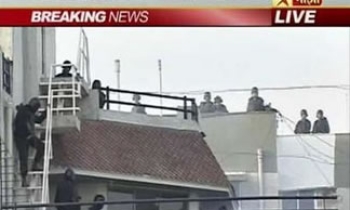Little newspapers, otherwise known as tabloids or "compact format" editions, are all the rage in Europe. Will they someday come to dominate U.S. newspapers?
Or, while we were looking the other way, have alien formats already made gains in the U.S. market?
Are we facing, in other words, the Invasion of the Broadsheet Snatchers?
It’s no secret that U.S. as well as European newspaper readership and media market share have been shrinking for decades. Newspapers themselves have been downsizing, too, as the web widths of both broadsheets and tabloids have decreased.
"Newspapers are getting smaller and smaller and smaller over time," said Tony Smithson, production director at The Courier-Journal in Louisville, Ky., a broadsheet that also publishes two weekend entertainment tab inserts and a year-old youth tabloid called Velocity.
But is small really beautiful? Is smaller better? Less more?
Across the Pond, the answer is "yes." The tabloidization of such formerly staid papers as The Times of London has delivered a severe jolt, of the life-giving kind, to a declining marketplace.
In the United States, however, the tab storyline - with some notable general-interest exceptions such as the Christian Science Monitor, Newsday in Long Island, N.Y., and the (Denver) Rocky Mountain News - has been one of a format used by broadsheet newspapers to stake out turf in special editions, mostly freebies, "youth," Spanish-language and other newspaper spin-offs, such as tab-sized classifieds.
One might conclude that U.S. publishers have thus far confined their interest in small formats to fringe markets.
Not true
One might conclude incorrectly, however. "I think, personally, that within five years to 10 years, broadsheets will be an anachronism," Smithson said. "You won’t see them much."
Tabloid and compact formats are a "hot topic because people are trying to find a newspaper format that readers want," said John Temple, editor, publisher and president of the Rocky Mountain News, which has been a tabloid since 1942.
"And then the other thing," Temple said, "is Americans looking at what is happening in London and going, Wow.’"
The U.K.’s Wow factor most recently climaxed in January, when Britain’s Audit Bureau of Circulations released December circ figures showing that just three U.K. national daily newspapers, all tabs, gained circulation, while distribution among papers overall slumped 3 percent.
The Independent and The Times, the two London broadsheets that went tab (or "compact," as they like to say, in order to differentiate themselves from more notorious London tabs such as the Daily Mirror), saw their respective circulation rise 6.2 percent and 2.5 percent during December, while the freebie Metro tallied an increase of 12.5 percent.
More robust
For the year, circ growth was even more robust, with The Independent recording a 12 percent jump while The Times’ circulation rose 11 percent.
Conversely, The Guardian, a broadsheet that ripped The Independent when it downsized, lost more than 4 percent of its December circulation, according to British industry publication MediaWeek U.K.
Also jumping on the Euro tab bandwagon were France’s Le Telegramme; and Germany’s Die Welt, which prints Die Welt Kompakt, a smaller version of the broadsheet national daily.
Yet, in the States, broadsheets are as strong numerically as ever.
Said Temple, "The truth is, still, that in mainstream newspapering you don’t see tabloids. There’s the Rocky and Newsday and a few others - the Chicago Sun-Times, the New York Post - (but) really only Newsday and the Rocky are what I would call general interest." (Editor’s note: Other U.S. tabs include the (New York) Daily News, the Boston Herald and the Philadelphia Daily News.)
Signs blossom
Still, there are signs aplenty that U.S publishers are watching European trends with much more than casual interest:
*In January, Knight Ridder Inc. Chief Executive Officer Tony Ridder said the chain had formed a task force to consider tabloid editions of its newspapers. "A tabloid size has a lot of appeal and there’s a track record in various places that indicates that (downsizing) really works and can boost circulation," Ridder said in a conference call. Reflecting that bullish assessment, Knight Ridder three weeks later purchased five free Bay Area tabs, including the Palo Alto (Calif.) Daily News.
*In January, The New York Times Co. said it would pay $16.5 million for 49 percent of the free commuter daily tabloid Boston Metro.
*In February, billionaire Philip Anschutz introduced the Washington Examiner, the Washington, D.C., version of the San Francisco Examiner, his free-circulation daily tabloid. There could be dozens more tab Examiners in the works: Anschutz’s Denver-based Clarity Media Group trademarked "Examiner" in U.S. cities nationwide.
*In the most intriguing development, Gannett Co. Inc. is reportedly ready to purchase a Berliner format press to print the Journal and Courier in Lafayette, Ind. It would be the first mainstream daily newspaper in the nation to be produced in that format (roughly 18 inches by 12 inches), which is narrower and taller than a tabloid. Gannett declined comment.
*Press vendors are retooling their machines to accommodate multiple web widths and cutoffs. Case in point: Goss International Corp.’s Flexible Press System, unveiled last year, features a changeable cutoff aimed at letting users produce a variety of formats with easy makeready.
"It’s a matter of handling," said Mike Ciarimboli, vice president of production at The (Nashville) Tennessean, about the attention paid to tabloids. (The Tennessean, a broadsheet, publishes a Friday tab, Weekend; a job listings tab, Career Builder; and, starting last autumn, All the Rage, a weekly youth tabloid.)
"If you think about where you pick up free publications, tabloids or compacts are ready to read, easier to handle and more convenient," Ciarimboli said.
Smaller formats also seem to fit into ideas about the place of newspapers, and literacy overall, in a fractured media universe. Format changes all have to do with "our notion of how to read," Smithson said.
So, should the industry brace itself for the coming tide of smaller newspapers?
Probably, yes. "I would not be surprised if, within the next couple of years, we see, if not a major daily, a mid-sized daily go" to the Berliner format, said Smithson.
Clues to future
In the meantime, the Rocky Mountain News and St. Louis Post-Dispatch might offer some clues for publishers evaluating a format swap.
Due to production limitations, the News began publishing a broadsheet Saturday edition in 2001 after it entered into a joint operating agreement with The Denver Post.
(Conversely, the Post-Dispatch, a broadsheet, publishes as a tab on Saturdays.)
News editor Temple was already producing a sectionalized daily tabloid when the Saturday broadsheet was thrown at him. "We were creating literally a new newspaper," he said. "I felt tremendous pressure to find an idea that wasn’t just OK, a throwaway, a milquetoast one day a week."
After a rocky start, today the Saturday paper appears to have succeeded, in part by recreating itself as the "weekend edition," Temple said. "It’s something to read for two days," he said, adding that the broadsheet edition represents the News’ second biggest revenue day of the week.
Few production challenges
While converting from broadsheet and tab doesn’t pose too many production challenges - "We can knock out tabs without any problem," said The Tennessean’s Ciarimboli - the real challenge is on the front end.
Pagination and design editors have to alter their usual processes in order to accommodate the change in size, advertisers have to be educated to provide the correct file sizes and one hundred and one other details have to be kept in order.
The wisdom of downsizing "depends on who your ad accounts are currently and what their needs are," said Rob Carrigan, publisher of the Woodland Park (Colo.) Ute Pass Courier and two other newspapers. His company, ASP Westward LP, switched all of its 14 papers from tab to broadsheet six years ago in a bid to please advertisers and standardize sizes.
Then there are subscribers. Although readers are quick to forget minor changes - a reduction in web width from 54 inches to 50 inches, for example - moving from broadsheet to tab, or vice versa, takes some getting used to.
That’s particularly the case for broadsheets that rely on subscribers rather than newsstand sales, the model followed by most U.S. newspapers.
According to a January 2005 McKinsey Quarterly report studying tabloidization, subscribership among subscriber-reliant broadsheets that switch to tab can drop 3 percent to 5 percent as readers "switch to other broadsheets or content themselves with other media."
The consultancy checked off other obstacles to switching formats, including challenges associated with motivating recalcitrant reporters and editors who might resist moving to a tabloid size.









